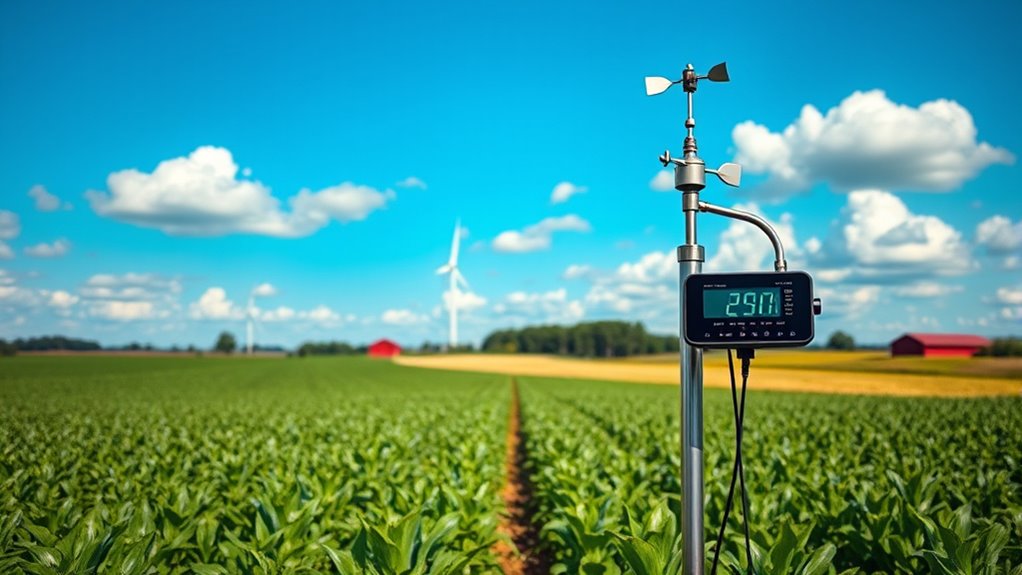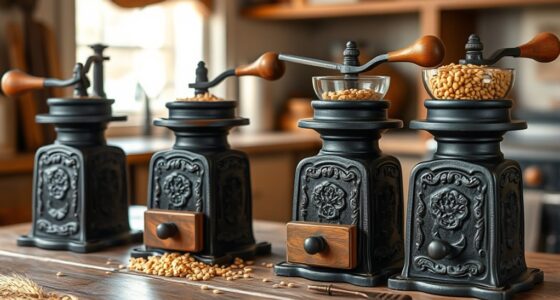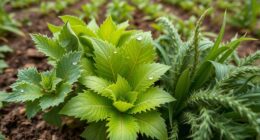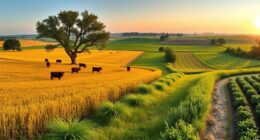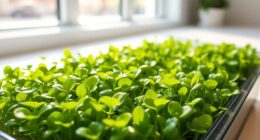If you’re looking for the best weather stations for farms in 2025, I’ve found some top options that deliver accurate, real-time data while being durable and easy to monitor remotely. These stations measure everything from temperature and humidity to wind and rainfall, helping you make informed decisions and optimize your farm operations. To find the perfect fit for your needs and see how these devices stand out, keep exploring the options below.
Key Takeaways
- Top weather stations offer real-time, highly accurate data on temperature, humidity, wind, rainfall, UV, and pressure for farm optimization.
- Wireless connectivity options like Wi-Fi, RF, and cellular enable remote monitoring across large farm areas.
- Support for multiple sensors and self-calibrating barometers improves measurement accuracy and forecast reliability.
- Durable, weatherproof designs ensure long-term outdoor use in extreme conditions with minimal maintenance.
- Integration with smart home platforms and alerts helps automate farm management and respond promptly to weather changes.
AcuRite Iris 5-in-1 Weather Station with LCD Display
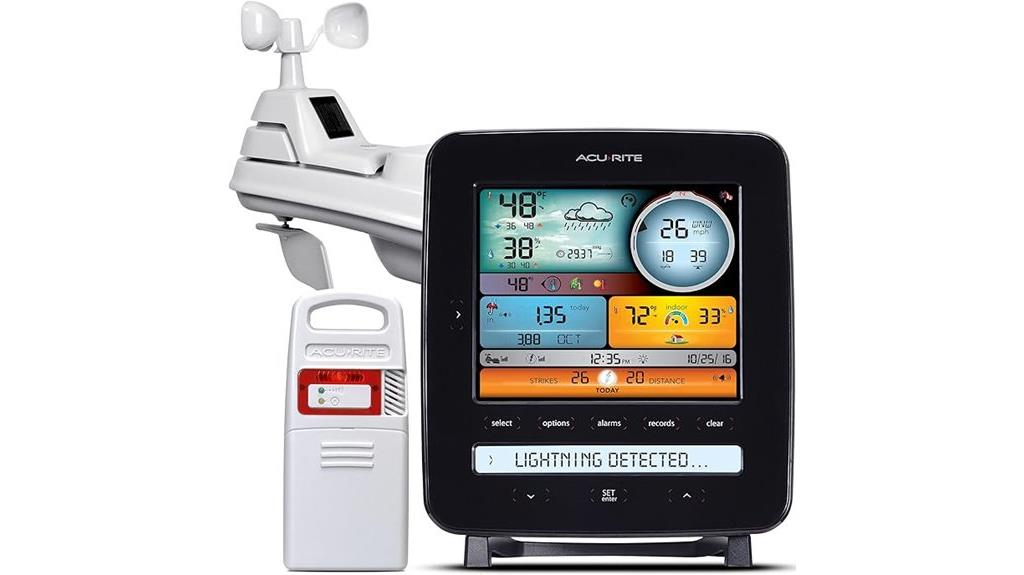
If you’re looking for a reliable weather station tailored for farms, the AcuRite Iris 5-in-1 stands out with its extensive real-time data and user-friendly LCD display. It provides detailed indoor and outdoor weather readings, including temperature, humidity, wind speed and direction, barometric pressure, rainfall, and lightning strikes. The color LCD is easy to read, auto-dims, and offers alerts, forecasts, and historical data. Wireless sensors ensure accurate measurements over large distances, and the self-calibrating barometer improves forecast reliability over time. Despite some setup challenges, most users appreciate its thorough data and clear interface, making it a valuable tool for farm management.
Best For: Farmers and outdoor enthusiasts seeking comprehensive real-time weather data with an easy-to-read display for effective farm management and outdoor planning.
Pros:
- Provides extensive indoor and outdoor weather metrics including wind, rainfall, and lightning strikes.
- Self-calibrating barometer enhances forecast accuracy over time.
- Large, color LCD display with auto-dimming and user-friendly interface.
Cons:
- Setup can be complex, requiring calibration and proper sensor placement.
- Sensitive to electrical noise, which may cause false lightning alerts or device resets.
- Limited forecast accuracy in certain regions and high battery consumption with 6 AA batteries.
Ambient Weather WS-2000 Smart Weather Station

The Ambient Weather WS-2000 Smart Weather Station stands out as a top choice for farmers who want reliable, real-time weather data at their fingertips. Its TFT color display makes it easy to monitor wind speed, direction, temperature, humidity, rainfall, UV, and solar radiation. The all-in-one wireless sensor array simplifies setup and provides accurate readings. Enhanced Wi-Fi connectivity allows me to transmit data remotely to a large personal weather station network, enabling alerts and updates from anywhere. Powered by a 5V DC adapter and batteries, this station offers all-encompassing weather monitoring with simple visualization, making it a valuable tool for smarter farming decisions.
Best For: farmers and outdoor enthusiasts seeking reliable, real-time weather data with remote monitoring capabilities.
Pros:
- Easy-to-read TFT color display for quick weather assessment
- Wireless all-in-one sensor array for comprehensive and accurate measurements
- Enhanced Wi-Fi connectivity enables remote data access and alerts
Cons:
- Requires 3 AAA batteries for the sensor array (batteries not included)
- Power adapter and batteries needed, which may add to setup complexity
- May be more expensive compared to basic weather stations with fewer features
Ambient Weather WiFi Weather Station with Remote Monitoring
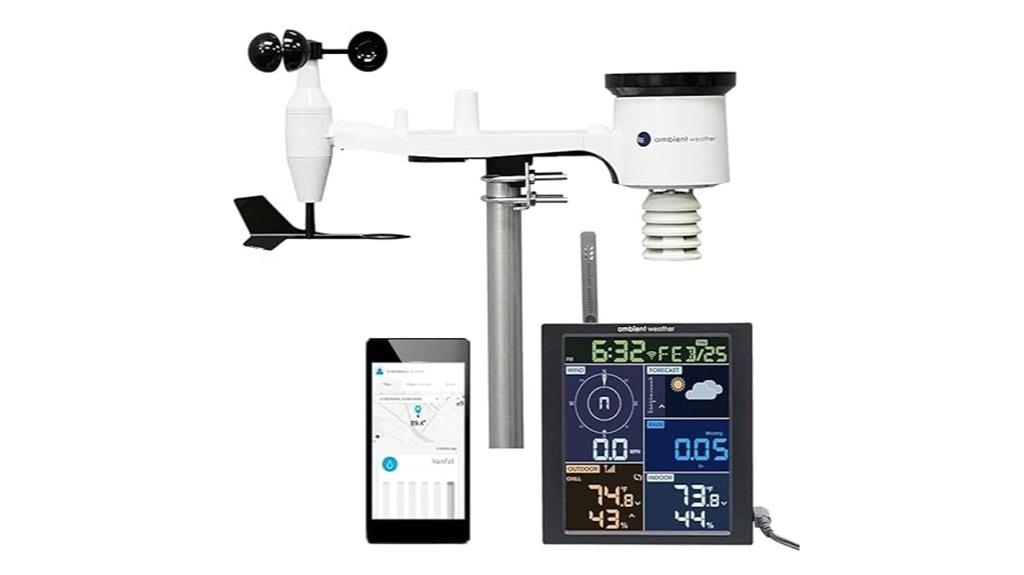
For farmers seeking reliable, real-time weather data, the Ambient Weather WiFi Weather Station with Remote Monitoring stands out as an excellent choice. It features an all-in-one sensor array that measures temperature, humidity, barometric pressure, wind speed, wind direction, and rainfall, providing 16-second updates displayed on a color LCD console. Its enhanced WiFi connects seamlessly to the Ambient Weather Network, enabling remote access, sharing with other stations, and optional alerts. The system integrates easily with smart home devices like Alexa and Google Home, allowing automation based on weather conditions. Durable and feature-rich, it’s a valuable tool for precise, actionable weather insights on your farm.
Best For: farmers and outdoor enthusiasts who need accurate, real-time weather data with remote monitoring and smart home integration.
Pros:
- Comprehensive all-in-one sensor array measuring key weather parameters
- Seamless WiFi connectivity for remote access, sharing, and alerts
- Durable design with a user-friendly color LCD display for real-time updates
Cons:
- Higher initial purchase cost compared to basic weather stations
- Requires stable WiFi connection for optimal performance
- Setup and configuration may be complex for non-technical users
Sainlogic WiFi Smart Weather Station SA9 with 24/7 Weather Forecast

Farmers seeking reliable, real-time weather updates will find the Sainlogic WiFi Smart Weather Station SA9 a valuable tool. It provides 24/7 accurate forecasts using Weatherseed® AI, with instant alerts via app or email. The 7-in-1 outdoor sensor measures temperature, humidity, rainfall, wind, UV, and sunlight, covering large areas with a 330 ft wireless range. Data updates every five minutes and can be analyzed through charts, graphs, or Excel downloads. The large 8.5-inch display organizes all essential weather info clearly. While setup and mounting can be tricky, the station’s extensive data and remote monitoring capabilities make it a worthwhile option for modern farms.
Best For: farmers and outdoor enthusiasts who need comprehensive, real-time weather data and forecasts to manage their land or activities effectively.
Pros:
- Provides 24/7 accurate weather forecasting with Weatherseed® AI and instant alerts via app or email.
- Covers large outdoor areas with a 7-in-1 outdoor sensor measuring essential weather parameters.
- Stores up to 2 years of historical data accessible through charts, graphs, and Excel downloads for detailed analysis.
Cons:
- Setup and mounting can be challenging, with limited mounting options and fragile materials.
- App usability issues, including connectivity problems, small interface text, and lack of advanced features.
- Accuracy concerns, especially with temperature deviations and static barometric pressure readings, may affect reliability.
Ambient Weather WS-2902 WiFi Smart Weather Station
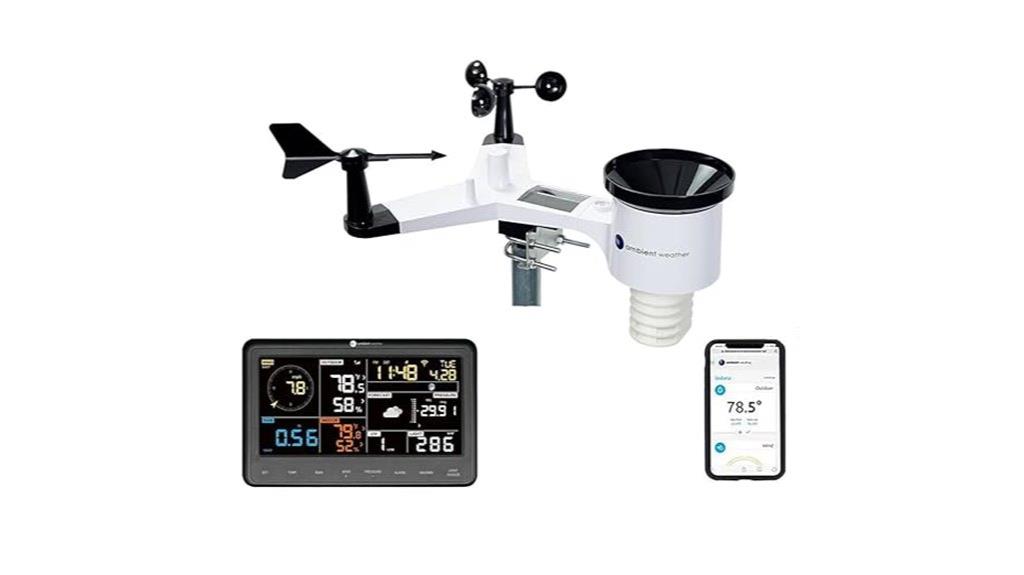
If you need precise, hyper-local weather data to make informed decisions on your farm, the Ambient Weather WS-2902 WiFi Smart Weather Station is an excellent choice. It offers extensive measurements, including wind speed and direction, temperature, humidity, rainfall, UV, and solar radiation, all displayed on a clear color LCD. Setup is quick and straightforward, with reliable Wi-Fi connectivity for seamless data transmission to platforms like Ambient Weather, WeatherCloud, and Weather Underground. The station’s high accuracy, real-time updates, and compatibility with smart home systems make it ideal for farm use. Customer support is responsive, and the build quality ensures durability. It’s a reliable tool for precision agriculture.
Best For: those seeking highly accurate, hyper-local weather data for farming, gardening, or outdoor activities, with smart home integration capabilities.
Pros:
- High accuracy measurements closely aligned with local weather stations
- Easy installation and reliable Wi-Fi connectivity for seamless data sharing
- Compatible with smart home systems like Alexa, Google Home, and IFTTT for automation and alerts
Cons:
- Limited customization options for the dashboard and data display tiles
- The console’s viewing angles and size could be improved with the upgraded WS-2000 model
- Restrictions on public weather data sharing through Ambient Weather’s website
Sainlogic Wireless Weather Station with Outdoor Sensor
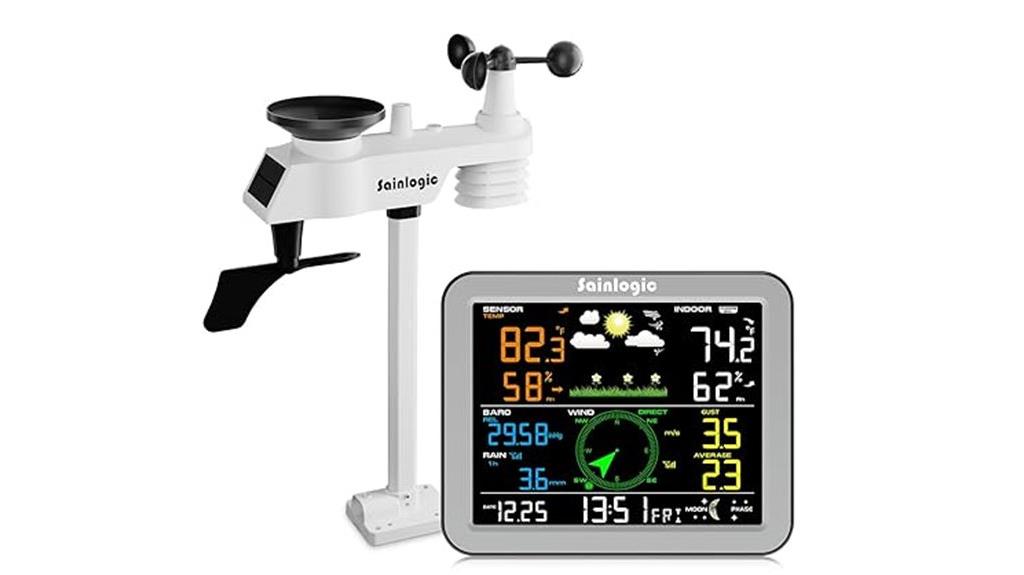
Are precise and real-time weather data essential for managing farm activities effectively? The Sainlogic Wireless Weather Station with Outdoor Sensor delivers just that. It provides accurate indoor and outdoor readings, including temperature, humidity, wind speed and direction, rainfall, and pressure. The outdoor sensor’s rain gauge and anemometer are praised for their accuracy, and the large LCD display ensures clear data visibility. Installation is simple—just mount the sensor and pair it wirelessly within 328 feet. Although it doesn’t support Wi-Fi or app connectivity, it offers reliable, straightforward monitoring perfect for farmers who want accurate, real-time weather insights to optimize their operations.
Best For: farmers, gardening enthusiasts, and outdoor activity planners seeking reliable, real-time weather data without complex connectivity.
Pros:
- Provides accurate indoor and outdoor measurements for temperature, humidity, wind speed, rainfall, and pressure.
- Easy to install with a straightforward wireless setup within 328 feet.
- Large, colorful LCD display ensures clear visibility and intuitive data reading.
Cons:
- Does not support Wi-Fi or app connectivity for remote monitoring.
- Wind direction readings can vary due to crosswinds, requiring observation over time for accuracy.
- Brightness adjustment options are limited, which may affect readability in certain lighting conditions.
AcuRite Iris Wireless Weather Station with Rain Gauge and Wind Speed/Direction

The AcuRite Iris Wireless Weather Station with Rain Gauge and Wind Speed/Direction stands out for its ability to deliver real-time, all-encompassing weather data, making it an ideal choice for farm management. It tracks over 55 data points, including temperature, humidity, wind speed and direction, rainfall, barometric pressure, dew point, and heat index. The station wirelessly transmits current conditions and creates personalized 12-hour forecasts using barometric data. Its large color LCD display consolidates indoor and outdoor info, and setup is simple—just install batteries and mount the outdoor sensor. Trusted since 1943, it offers reliable, high-quality data to help optimize agricultural decisions.
Best For: farmers, outdoor enthusiasts, and weather monitoring professionals seeking comprehensive real-time weather data and forecasts.
Pros:
- Provides over 55 detailed weather data points, including wind speed, direction, and rainfall.
- Wireless setup with easy installation of outdoor sensor, no complex wiring needed.
- Large color LCD display consolidates indoor and outdoor conditions for quick, easy reading.
Cons:
- May require regular maintenance or battery replacements for outdoor sensors.
- Advanced features and data points might be overwhelming for casual users.
- The initial cost could be higher compared to basic weather stations.
Sainlogic Wireless Weather Station with Outdoor Sensor
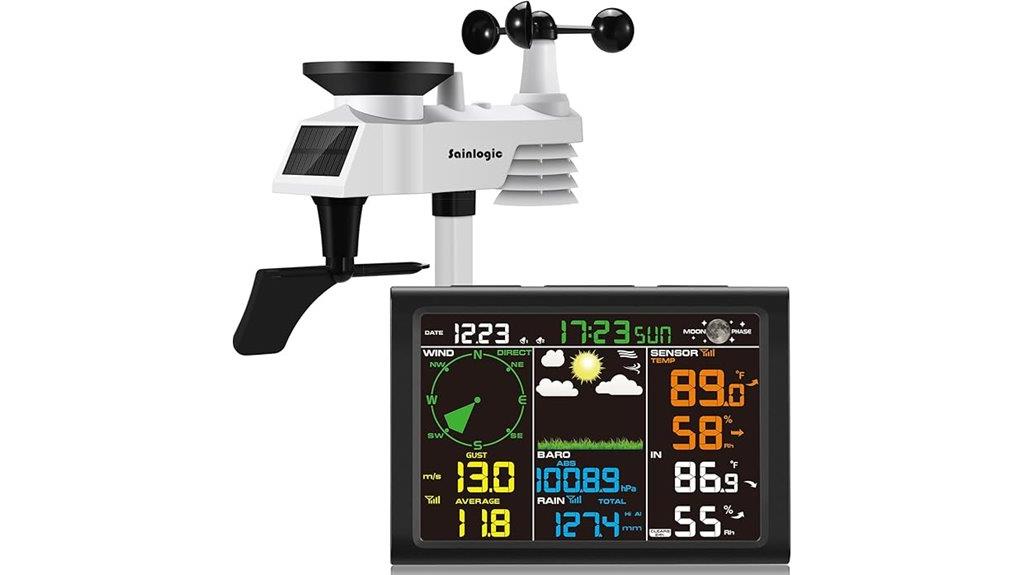
The Sainlogic Wireless Weather Station with Outdoor Sensor stands out for its all-encompassing real-time weather tracking, making it ideal for farmers who need accurate, up-to-the-minute data to manage their operations effectively. It measures rainfall, wind speed and direction, air pressure, humidity, indoor and outdoor temperatures, and moon phases, providing reliable data with ±1.8°F temperature accuracy. The wireless outdoor sensor transmits signals up to 328 feet, ensuring stable readings even through obstacles. Its large, color-coded LCD display offers easy navigation and quick data recognition. With simple setup, alarm functions, and versatile mounting options, this station delivers comprehensive weather insights to optimize farm management.
Best For: farmers, gardeners, and outdoor enthusiasts seeking accurate, real-time weather data to enhance their operational decisions.
Pros:
- Comprehensive weather monitoring including rainfall, wind, pressure, humidity, and temperature
- Reliable wireless outdoor sensor with transmission up to 328 feet for stable data collection
- Large, color-coded LCD display with easy navigation and versatile mounting options
Cons:
- No WiFi or app connectivity for remote access or data sharing
- Requires battery replacements for the outdoor sensor, as it does not recharge batteries
- Dark display colors can hinder visibility from a distance in low-light conditions
Sainlogic WiFi Smart Weather Station with 8.5″ Display
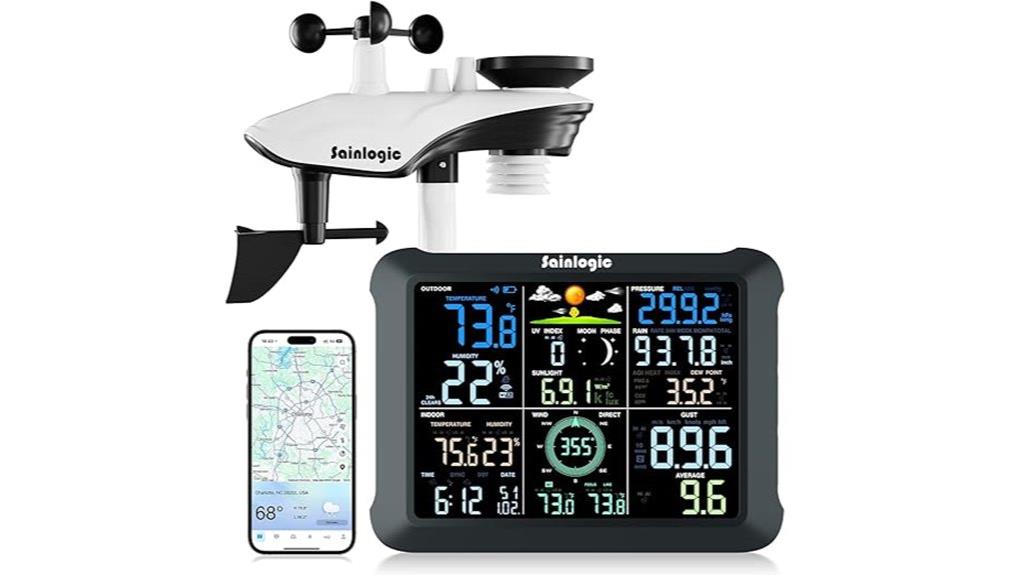
Looking for a weather station that offers detailed, real-time data to help manage farm conditions effectively? The Sainlogic WiFi Smart Weather Station with an 8.5″ display fits the bill. It provides 24/7 weather forecasting via Weatherseed® AI, with instant alerts through the app or email. The 7-in-1 outdoor sensor measures temperature, humidity, rainfall, wind, UV, and sunlight within a 330 ft range, updating every five minutes. The large display shows all vital data clearly, and you can access two years of historical data through charts and Excel downloads. While setup and app usability have some issues, it’s a solid option for extensive farm weather monitoring.
Best For: farmers, gardeners, or outdoor enthusiasts seeking comprehensive real-time weather data and alerts for farm management and outdoor activities.
Pros:
- Large 8.5-inch display with clear organization of multiple weather parameters
- 24/7 weather forecasting with Weatherseed® AI and remote alerts via app or email
- Stores up to 2 years of historical data for in-depth analysis through charts and Excel downloads
Cons:
- Occasional accuracy issues with temperature and barometric pressure readings
- WiFi connectivity and app usability problems reported by users, including setup difficulties
- Limited mounting options and short battery life of outdoor sensors, especially in winter conditions
La Crosse Technology 328-69357-INT Wi-Fi Professional Weather Station
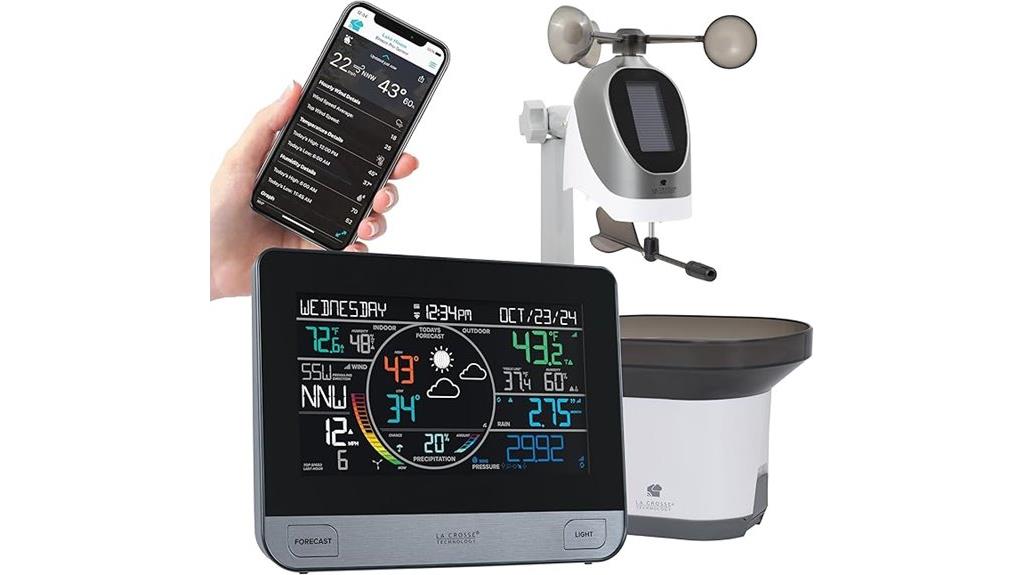
Farmers seeking accurate, real-time weather data will find the La Crosse Technology 328-69357-INT Wi-Fi Professional Weather Station an excellent choice, especially if they want remote monitoring capabilities. It provides precise indoor and outdoor measurements, including temperature, humidity, wind speed and direction, rainfall, and barometric pressure, with detailed historical data. The station connects via Wi-Fi and pairs with the La Crosse View app, allowing me to monitor conditions remotely, set alerts, and review trends. Its durable design, easy setup, and expandability make it ideal for farms. Rated highly for accuracy and user-friendly features, it’s a reliable tool to optimize agricultural decisions.
Best For: Farmers, gardening enthusiasts, and weather-conscious homeowners seeking accurate, real-time, and remotely accessible weather data to inform their decisions.
Pros:
- Comprehensive indoor and outdoor weather measurement including wind, rainfall, and barometric pressure
- Wi-Fi connectivity with the La Crosse View app for remote monitoring and alerts
- Durable build with easy setup and expandability for additional sensors or displays
Cons:
- Batteries for sensors are not included, requiring purchase of quality batteries separately
- Sensor disconnections can occur if low-quality batteries are used
- Slightly higher price point compared to basic weather stations, but with added features
Tempest Weather System with Wind Meter and Alexa Integration
If you need precise, real-time weather data that easily integrates with your smart home setup, the Tempest Weather System with Wind Meter and Alexa is an excellent choice. It features a solar-powered outdoor sensor that wirelessly transmits updates every 3 seconds over a 1,000-foot range. The system measures wind speed, direction, rain, temperature, humidity, UV, lightning, and more, providing highly accurate forecasts trusted by experts. Its seamless integration with Alexa and other smart platforms allows for automation—like adjusting irrigation or lighting based on conditions. Easy to install and maintain, the Tempest offers reliable, hyper-local data perfect for optimizing farm operations.
Best For: those seeking highly accurate, real-time hyper-local weather data with seamless smart home integration for both personal and professional use.
Pros:
- Provides precise measurements of wind, rain, temperature, humidity, UV, and lightning with real-time updates every 3 seconds
- Easy installation with wireless transmission up to 1,000+ feet and minimal maintenance due to solar power and no moving parts
- Compatible with Alexa, IFTTT, and other smart home platforms for automation and enhanced user control
Cons:
- Higher initial cost compared to basic weather stations
- Some users may experience device longevity concerns, estimating around five years of reliable operation
- Occasional data outliers during extreme weather events that may require calibration or adjustments
WiFi Weather Station with Rain Gauge and Wind Speed
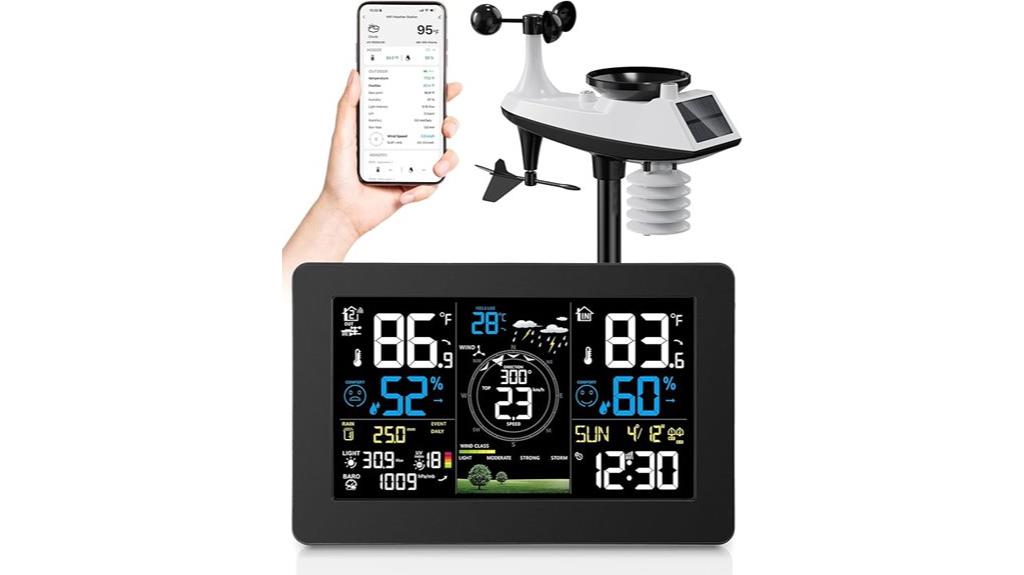
Ever wondered how to get precise, real-time weather data directly on your farm? I’ve found that a WiFi Weather Station with Rain Gauge and Wind Speed offers exactly that. Its large 7.5-inch HD display shows temperature, humidity, wind, rainfall, pressure, UV index, and forecasts clearly, even at night. With WiFi, I can access live and historical data remotely via a dedicated app—adjusting brightness, setting alarms, or tracking trends. High-precision sensors deliver accurate wind and rainfall measurements, supporting up to three remote sensors. Powered by AC, solar, or batteries, it’s straightforward to install and perfect for outdoor farming environments.
Best For: Farmers, gardeners, and outdoor enthusiasts who need accurate, real-time weather monitoring to make informed decisions.
Pros:
- Large 7.5-inch HD display with adjustable brightness for clear visibility day or night
- WiFi connectivity allows remote access to live and historical weather data via the dedicated app
- High-precision sensors support accurate measurement of wind, rainfall, UV index, and other weather parameters
Cons:
- Requires an AC/DC power adapter or solar/batteries (batteries not included), limiting portability when on battery power
- WiFi connection only supports 2.4GHz networks, which may be incompatible with some routers
- External sensors need proper installation and maintenance, especially in harsh outdoor conditions
AcuRite Iris Weather Station with Rain Gauge and Wind Speed/Direction
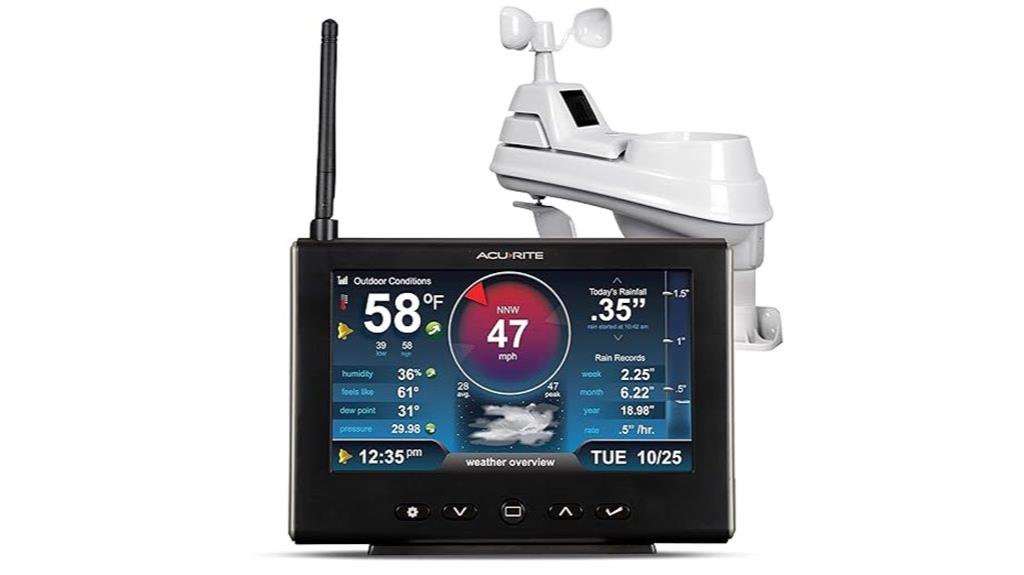
The AcuRite Iris Weather Station with rain gauge and wind speed/direction is an excellent choice for anyone managing small farms or homesteads who needs real-time, hyperlocal weather data. It features wireless sensors for outdoor and indoor monitoring, including rain gauge, wind speed and direction, temperature, humidity, and barometric pressure. The high-definition display shows detailed data, moon phase, and weather forecasts based on barometric trends. Setup is simple—install batteries, mount sensors, and connect wirelessly. While its readings are accurate and reliable, some users report occasional sensor or display issues. Overall, I find it valuable for tracking weather patterns and receiving alerts to protect crops and property.
Best For: small farm or homestead owners needing real-time, hyperlocal weather data to protect crops and property.
Pros:
- Accurate, reliable indoor and outdoor weather readings with detailed data display
- Easy to set up with wireless sensors and customizable alarms for various weather conditions
- Provides comprehensive information including rain, wind, temperature, humidity, barometric pressure, and moon phase
Cons:
- Occasional sensor or display malfunctions after extended use
- Limited customer support options and potential issues with sensor pairing or calibration
- Environmental factors like high winds or debris can affect sensor accuracy and performance
Newentor Wireless Weather Station with Atomic Clock and Barometric Pressure
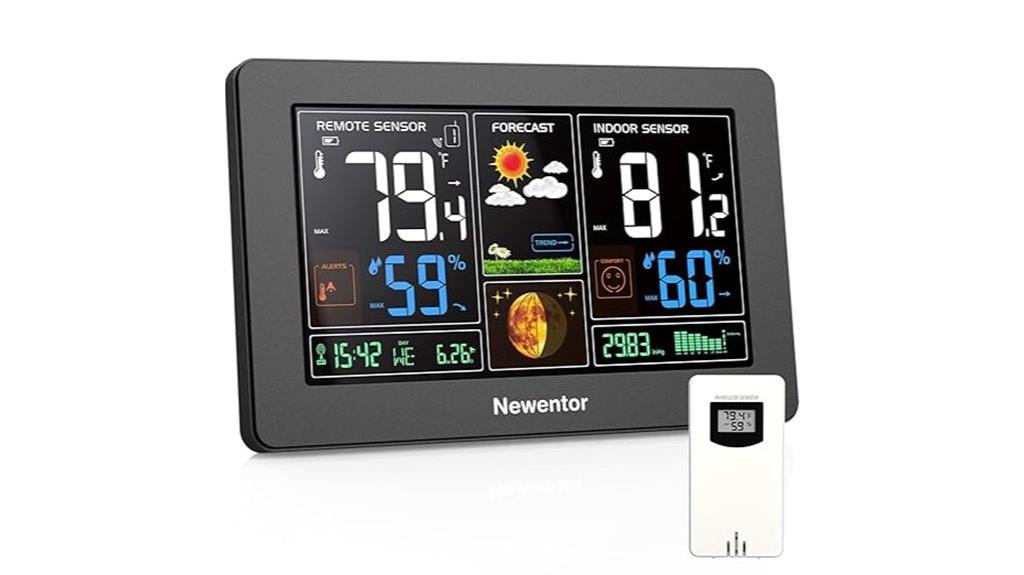
The Newentor Wireless Weather Station with Atomic Clock and Barometric Pressure stands out as an ideal choice for farmers who need reliable, real-time environmental data. Its 7.5-inch color LCD display provides detailed insights, including indoor and outdoor temperature, humidity, weather forecasts for the next 12-24 hours, moon phase, and barometric pressure. It supports up to three remote sensors, allowing me to monitor multiple locations easily. The atomic clock ensures precise time, while the adjustable backlight and power options make it versatile for various settings. With customizable alerts and calibration for accuracy, this station helps me stay ahead of weather changes vital for farming decisions.
Best For: Farmers and outdoor enthusiasts seeking accurate, real-time environmental data and weather forecasting to inform their activities.
Pros:
- Supports multiple remote sensors for monitoring various locations simultaneously
- Provides detailed weather forecasts, moon phase, and barometric pressure readings
- Features atomic clock with precise time synchronization and customizable alerts
Cons:
- Calibration over 7-10 days may require patience before accurate forecasts are established
- Larger display size may limit portability for some users
- Power options may necessitate continuous power supply for full features
Factors to Consider When Choosing Weather Stations for Farms
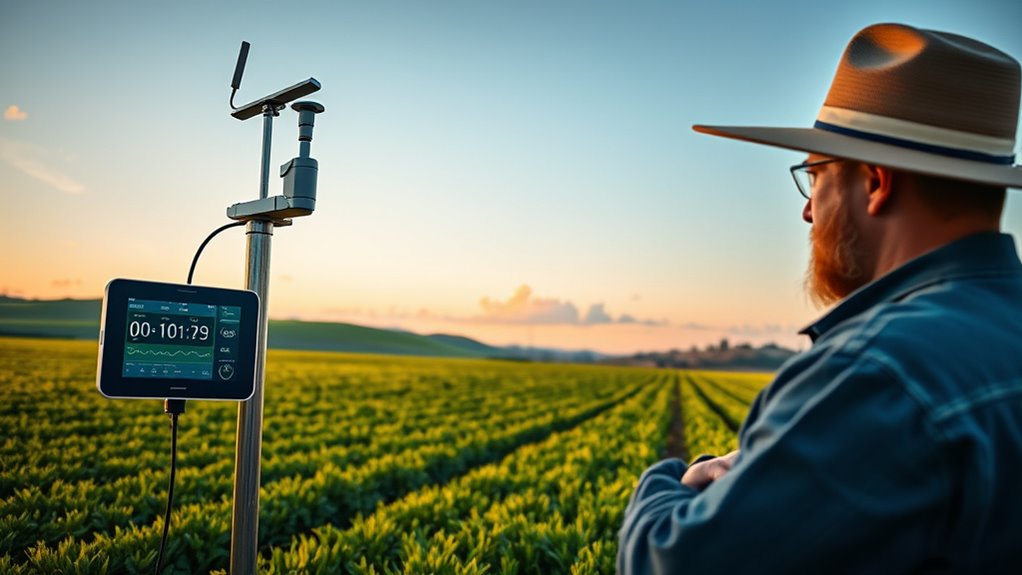
When selecting a weather station for your farm, I focus on measurement accuracy and sensor placement to guarantee reliable data. I also consider how the device connects to other systems and whether it offers useful weather forecasts. Ultimately, durability is key, so I look for stations built to withstand tough weather conditions.
Accuracy of Measurements
Choosing a weather station for farm use means prioritizing measurement accuracy, as even small errors can lead to poor decision-making. I look for stations that provide temperature readings within ±1°C or better, ensuring reliable data to guide planting and irrigation. Accurate wind speed and direction measurements are essential, especially sensors that can detect gusts and perform well across environmental conditions. Rainfall gauges should be well-calibrated, capable of recording tiny increments like 0.01 inches or 0.2 millimeters for precise precipitation tracking. Barometric pressure readings need to be stable and responsive, with self-calibrating sensors that adapt over time for better forecasting. Finally, sensor placement and shielding are fundamental to minimize interference, ensuring measurements remain accurate despite environmental influences.
Sensor Range and Placement
Ensuring accurate weather data across a farm depends heavily on sensor range and placement. I recommend choosing weather stations with outdoor sensors that have a wireless transmission range of at least 300 feet to cover large areas reliably. Proper placement is vital: rain gauges and wind sensors should be positioned in open, unobstructed spaces, ideally 15-20 feet above ground, to avoid interference from structures or vegetation. Durability matters too—sensors must withstand extreme temperatures, high winds, and precipitation for consistent performance. Additionally, placing sensors away from electrical noise, machinery, and electromagnetic interference guarantees clear wireless signals. For farms with extensive or irregular terrain, deploying multiple sensors can provide thorough coverage and localized insights, optimizing data accuracy across the entire property.
Data Connectivity Options
Selecting the right data connectivity option is crucial for reliable weather monitoring on farms. Wi-Fi is ideal if you have a stable internet connection, enabling real-time data access through apps or cloud platforms from anywhere. For larger farms, RF radio frequency offers long-range, low-latency data transmission, but it may need line-of-sight or specific mounting. Bluetooth stations are suited for small farms or localized monitoring, with ranges up to 100 meters and no internet dependence. Cellular-connected stations use SIM cards and GSM networks, making them perfect for remote areas with limited Wi-Fi, though they often involve ongoing data plan costs. Your choice depends on farm size, infrastructure, and connectivity needs, ensuring consistent, accurate data transmission for effective farm management.
Weather Forecasting Ability
Reliable weather forecasting depends heavily on the quality of sensors and data processing capabilities of the station. High-quality sensors for temperature, humidity, wind speed, and barometric pressure provide the essential data needed to predict weather accurately. Self-calibrating barometers improve forecast precision by detecting pressure trends over time, reducing errors. Advanced stations equipped with AI or sophisticated algorithms analyze historical data to generate short-term, farm-specific forecasts, often up to 12 hours ahead. Incorporating lightning detection and rainfall data further enhances predictions, especially for storm alerts critical to farming operations. The frequency of data updates—every 1 to 5 minutes—and the station’s ability to process environmental changes rapidly markedly impact forecast accuracy. Choosing stations with these features ensures more dependable, timely weather information for your farm.
Durability in Weather
When choosing weather stations for farms, durability is a critical factor that can’t be overlooked. I look for units with robust, weatherproof enclosures rated at least IP65, ensuring they can withstand rain, snow, dust, and UV exposure. Materials like stainless steel, reinforced plastics, and corrosion-resistant coatings are essential to handle harsh environmental conditions over time. Sensors must operate reliably across a wide temperature range, from -40°C to +60°C, to cope with seasonal extremes. Wireless components should have strong signal resistance and stable connections to prevent data loss during storms or high winds. Regular maintenance, such as cleaning and calibration, is vital to keep sensors accurate and extend the device’s lifespan. Durability guarantees consistent performance and long-term value for my farm’s data needs.
Ease of Installation
Durability is key when choosing weather stations for farms, but ease of installation can make a significant difference in how smoothly the setup process goes. I recommend selecting models with clear, simple instructions and minimal wiring, which saves time and reduces frustration. Wireless sensors with long-range connectivity—at least 200 feet—allow flexible placement without extensive cabling. Look for stations that offer adjustable mounting options, like wall mounts or free-standing stands, so you can adapt to your farm’s layout and terrain. Additionally, devices with detailed setup guides or app-assisted configuration simplify calibration and sensor positioning. Prioritizing weather-resistant sensors ensures reliable outdoor performance, even in harsh conditions. Overall, an easy-to-install station helps you get accurate data quickly, so you can focus on optimizing your farm’s operations.
Frequently Asked Questions
How Do Weather Stations Help Optimize Crop Irrigation Schedules?
Weather stations help me optimize crop irrigation schedules by providing real-time data on rainfall, temperature, humidity, and wind. With this information, I can determine exactly when and how much to water, avoiding over- or under-watering. This not only conserves water but also guarantees my crops receive the right amount of moisture, leading to healthier growth and better yields. It’s like having a personalized irrigation planner right on my farm.
Can Weather Stations Predict Pest Outbreaks Based on Climate Data?
Imagine a sky filled with silent whispers of impending trouble—that’s what weather stations can do for us. They analyze climate patterns to help predict pest outbreaks, giving us a vital edge. By monitoring humidity, temperature, and rainfall, I can anticipate pest activity before it strikes. This proactive approach allows me to take timely actions, protect my crops effectively, and reduce reliance on chemical interventions.
What Is the Average Lifespan of a Farm Weather Station?
The average lifespan of a farm weather station is typically about 5 to 10 years. I’ve found that proper maintenance and timely upgrades can extend its useful life. Regularly replacing sensors and keeping the device protected from harsh weather helps guarantee accurate readings. I recommend checking manufacturer guidelines and investing in reliable models to maximize your station’s longevity and get the best data for your farm.
How Do Weather Stations Integrate With Farm Management Software?
Weather stations typically integrate with farm management software through wireless connections like Wi-Fi or Bluetooth. I connect the station’s data directly to my software via APIs or dedicated apps, which automatically sync real-time weather info. This seamless integration helps me monitor conditions, plan activities, and optimize crop management efficiently. It’s a game-changer, making data-driven decisions faster and more accurate, ultimately boosting my farm’s productivity.
Are There Weather Stations Designed Specifically for Organic Farming Practices?
Isn’t it true that every farm, especially organic ones, deserves tailored tools? Yes, there are weather stations designed specifically for organic farming practices. These stations focus on soil health, organic pest management, and sustainable water use. They provide precise data to help organic farmers make informed decisions without compromising their methods. Investing in such specialized equipment guarantees your farm stays aligned with organic principles, boosting productivity and environmental harmony.
Conclusion
I’ve found that investing in a reliable weather station isn’t just about data—it’s about gaining confidence in your farm’s future. Think about it: accurate weather info can be the difference between a bumper harvest and unexpected losses. So, I believe that choosing the right station, tailored to your needs, truly empowers you to make smarter decisions. After all, in farming, knowledge is your most valuable crop.

